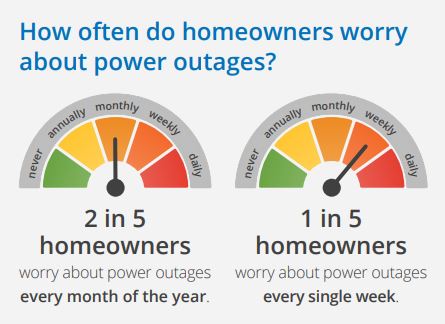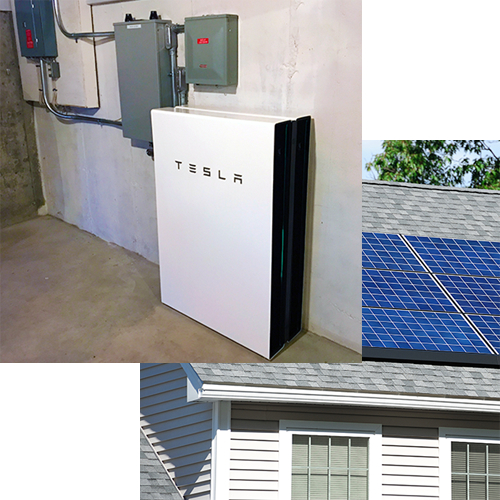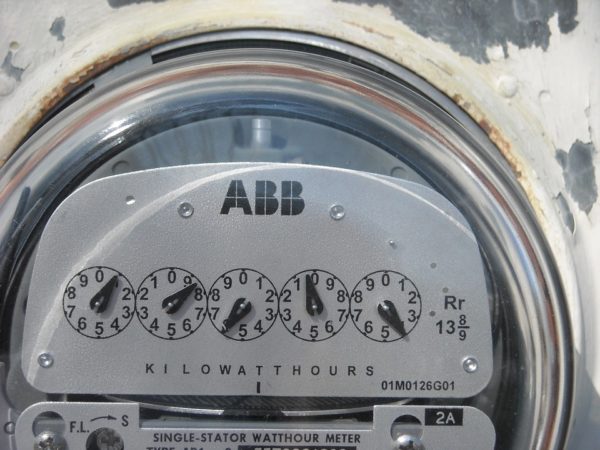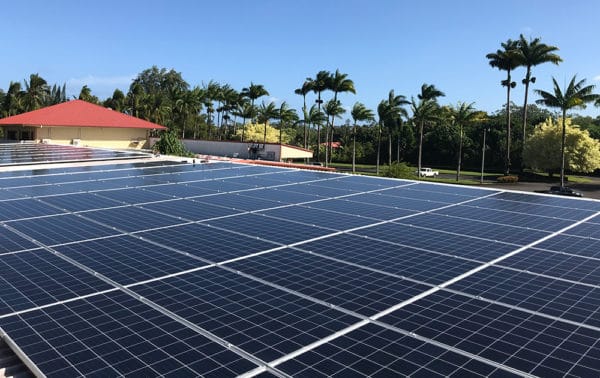Attaching a solar array to a home is a long-term commitment, with many considerations, and one that offers great potential for energy bill savings. A recent addition to the list of options is whether or not to attach a battery energy storage system.
A battery can often add $10,000 or more to the total cost of a residential solar system, according to EnergySage. But it comes with a range of benefits that vary depending on the home’s electricity needs and experience with the utility company. So, what are the benefits?
Backup power
Blackouts or power outages occur with varied frequency and for different reasons, depending on location. Some regions experience transmission issues on the grid, weather events can knock out power, and some regions like southern California have scheduled rolling blackouts during high energy-demand periods.

Image: SunPower
A SunPower-backed survey of 1,500 homeowners found that 40% of respondents worried about power outages on a monthly basis. And one-third of respondents said high-profile outages, like the ones caused by winter storms in Texas this past February, are the top reason for considering energy storage.
The next logical question might be: how much battery to install, and for how long should it provide backup?
Installers typically give the choice between whole-home backup, which often require the installation of multiple batteries, or a partial backup, which allows the homeowner to select specific circuits that are tied to desired appliances or outlets. When selecting specific breakers, homeowners often select the refrigerator, garage door opener, home office, or other kitchen appliances.
To understand a home’s power needs, and to evaluate what is most essential to back-up, homeowners can use the Department of Energy’s Energy Saver appliance energy calculator.
One of the most common home batteries is the Tesla Powerwall, which has a 13.5 kWh usable storage capacity. This means it can provide 13.5 kW for one hour, or 1 kW for 13.5 hours, said EnergySage. A second big energy storage brand is from LG Chem, which has 9.6 kWh and 16 kWh models.

Image: Green Mountain Power
Image: Green Mountain Power
Translated to appliances, EnergySage said 13.5 kWh is equivalent to running a 3,500 W air source heat pump for just under four hours, a 200 W refrigerator for 67.5 hours, or five 20 W light bulbs for 135 hours.
EnergySage said a PowerWall can typically back up essentials like WiFi, phone, refrigerator, and some lights for about 24 hours.
Simulations run by the Energy Department’s Lawrence Berkeley Laboratory of residential solar and storage systems operated for backup power purposes suggest that a system with a 7 kW pv array and 10 kWh of storage could support 60-80% of a customer’s average daily load over the course of a year, depending on the region.
Plus, if the sun is still shining, a battery-connected solar array will continue to produce and store electricity. Solar arrays without a battery must power down during an outage, for safety reasons. Without a battery to store the power, there is no safe place for the power to go, so the system must use a rapid shut down device (the grid is inaccessible as it’s being repaired).
Solar installers will typically work with a homeowner to determine backup needs, and will evaluate the readiness of the home’s main electrical panel to be integrated for backup. In some cases, the installer will call for a main panel upgrade to accommodate the battery, Doing this may come at an additional cost.
Smarter, more valuable
Without a battery, a grid-tied home solar array will export any unused power directly to the grid in real-time. With a battery, electricity can be charged and discharged in ways that optimize energy bill savings.

Image: Pixabay
Take demand charges, for instance. Some utilities, including providers in Massachusetts, Arizona, and Illinois, charge an additional fee based on the maximum amount of power required over a single hour, or 15-minute period, in a given month. A battery can be scheduled to discharge power during peak use times so that peak energy demand is smoothed, and demand charges are lower.
Utilities also use a billing design called time-of-use, which, similarly to demand charges, are intended to discourage power use during peak demand periods. For example, a utility may charge a lower rate of $0.15/kWh during off-peak hours, and then increase the rate to $0.32/kWh.
With a battery, the home is able to store energy during off-peak hours, which typically occur during the day when the solar array is producing the most. The battery can then export power to the home during on-peak hours, which are often in the evening as people return from work and run appliances and the array produces less power. Without a battery, homeowners are subject to whatever rate is being charged if the array is not actively producing.
A third benefit is the ability of the battery to provide value in utilities without net metering. Net metering is the process of exporting energy to the power grid in exchange for credits that can be used to offset utility bill costs.

Image: ProSolar Hawaii
Some utilities offer a one-to-one value, meaning each kWh of power sent out will cover one kWh of utility bill costs. Others have a decreased value for net metering.
For example, power may be billed by the utility at $0.16/kWh, but the value of exported energy only offers a credit value of $0.08/kWh. Other utilities offer no net metering credit whatsoever, like in Hawaii, where battery attachment rates are much higher than the rest of the United States at 80%. Again, in the net metering scenario, batteries are able to store and provide power, limiting exposure to the value loss in poor net metering climates.
Cost factors
A lithium-ion home battery comes with a sizeable price tag, usually around $10,000. Currently, energy storage that is paired with a residential solar system is eligible for the 26% federal investment tax credit.
Certain states and utilities offer additional incentives for including batteries, and in some cases the value adder can make a dramatic difference. The SMART program in Massachusetts, the Self-Generation Incentive Program (SGIP) of California, and incentive programs in Maryland and Long Island provide up-front cost relief for batteries.
Programs like ConnectedSolutions of New England offer further savings to homeowners who opt-in to a “bring-your-own-battery” program, wherein an incentive is paid to homeowner who agree to allow their batteries to export power to the grid during times of extreme peak demand.
In addition to the ticket-price of the battery, there may be hardware costs associated, as well. Tesla estimates supporting hardware for the battery costs $1,100, and installation will range from $800 to $2,000. Electrical work like a main panel upgrade may drive costs higher, and some installers will require the customer to cover costs like permit fees or retailer/connection charges, said EnergySage.
Install now or retrofit later?
Bloomberg’s New Energy Finance reports lithium-ion battery pack prices have fallen 87% from 2010 to 2019. With global supply chains ramping up lithium production due to increased demand (also driven by electric vehicle adoption) it is possible that further price reductions may occur. But is it worth waiting for a cheaper battery?

Image: GAF Energy
The answer depends, but in the past, the cost of installing a battery after-the-fact, or “retrofitting”, is dependent on the inverters on the array, said EnergySage. Most home solar arrays are installed with AC-coupled inverters, which would then need to be re-converted by an additional inverter back to DC for use by the battery. This means a retrofitted battery would come with an additional cost of another inverter, plus installation costs.
A solar system with a battery included at initial install can include just one DC-coupled inverter, which reduces costs, and converts and stores energy more efficiently than AC-coupled solutions.
Now that the Inflation Reduction Act of 2022 is law, the 30% Investment Tax Credit applies not just to solar-paired batteries, but also to standalone storage. This has made retrofits and standalone installations more common among installers.
Inverter companies are actively working to make retrofits easier. For example, Enphase recently released a microinverter that the company said can be retrofit to any type of home energy storage battery without the need for recoupling
This content is protected by copyright and may not be reused. If you want to cooperate with us and would like to reuse some of our content, please contact: editors@pv-magazine.com.









With my system, I used Deep Cycle marine/RV lead acid batteries starting in 2007 for both nighttime use and backup power. I am still waiting for a commercially built, safe, lithium batteries to replace them that would cost the same over time. My 80-100 AMP HOUR lead acid batteries cost about $7,200.00 and last 6 years. A commercially built system, using lithium batteries, that is equivalent in storage and output would run $28,000.00 to $36,000.00, depending on configuration, and last 12 years at today’s prices. My system pro-rates at $100.00 per month over time. A lithium-based system pro-rates at $200.00 per month over time. Battery replacements do not fall under the IRA guidelines. Only the first install does. Replacements will be totally at the owner’s expense.
I wish more effort were being put into systems that allowed the connection of EVs to residential systems to allow the mixed use of vehicles as emergency power supplies – also, with a slowly aging fleet of EVs coming onto the market, being able to repurpose them to provide storage would be a real win-win –